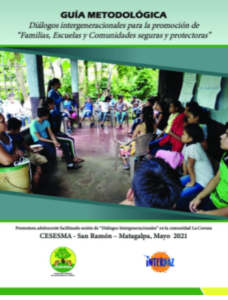Publications
Promoting a dialogue between children, adolescents, and adults is an important strategy for raising awareness and preventing gender-based violence. In rural communities of northern Nicaragua, Cesesma has promoted intergenerational dialogues for building community pacts signed with the participation of children, adolescents, family members, teachers, and local authorities. The communities undergo training on gender inequalities and gender-based violence and, based on the experiences and feedback of children and adolescents, prepare a diagnostic report and an action plan with practical measures that will safeguard the group’s right to live without violence.
The principle that guides the process of collectively building community pacts is that of the right of civic engagement of young people and children, and the promotion of equitable relationships between children and adults. Community organizing is the basis for this methodology, in that it encourages debate between different actors and promotes the deconstruction of behaviors and mindsets that naturalize various forms of violence, especially gender-based.

This guide presents all the steps to promote intergenerational dialogues and collectively build community pacts in order to prevent gender-based violence.
The active participation of children and adolescents is a fundamental step in ensuring that their experiences and proposals are acknowledged, in addition to strengthening violence prevention strategies. Children and adolescents who drew up pacts and participated in their monitoring have also assisted in the production of this publication.
Caso o download não inicie clique aqui para baixar.
Caso o download não inicie clique aqui para baixar.
Caso o download não inicie clique aqui para baixar.
Caso o download não inicie clique aqui para baixar.